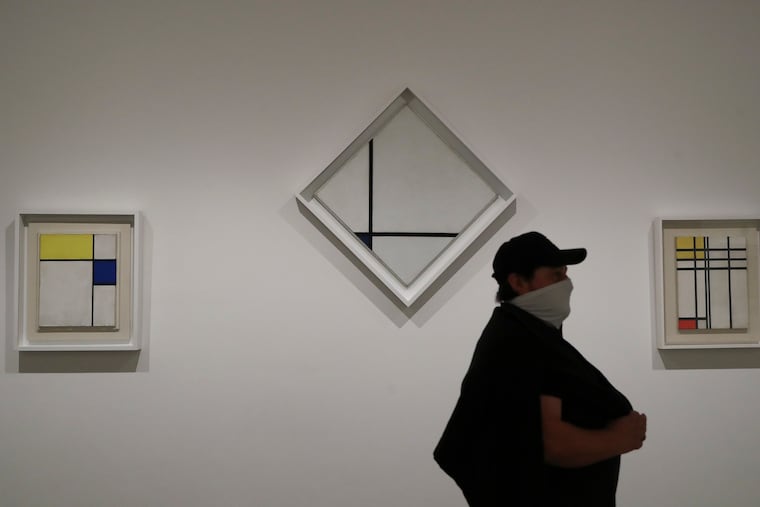Philly Art Museum faces ownership challenge over classic 20th-century work of modernism
Heirs to the estate of artist Piet Mondrian claim "Composition with Blue" painting is Nazi loot.

A masterpiece of modernist art that has been in the collection of the Philadelphia Museum of Art for almost 70 years has been characterized as “Nazi-looted art” by representatives of the artist’s heirs who plan to challenge museum ownership in court, although the artist never objected during his lifetime.
The painting, Composition with Blue, a 1926 work by Dutch artist Piet Mondrian, was purchased in 1939 by famed collector A.E. Gallatin, who acquired it from the Buchholz Gallery in New York, a sales outlet favored by the Nazis.
Gallatin displayed the work — with Mondrian’s assistance and approval — in his famed Gallery of Living Art at New York University, museum officials said, and in 1952, he bequeathed it to the PMA along with much of the rest of his collection.
Lawyers for Mondrian’s heirs said they began legal action last week.
“We filed an action, in the Court of Common Pleas, that basically states that this picture was seized by the Nazis, belonged to Mondrian, and his heirs have a right to recover it,” said New York attorney Lawrence M. Kaye. “American museums should not be keeping Nazi-looted art. That’s it in a nutshell.”
Mondrian, who died in New York in 1944, never objected to or disputed Gallatin’s ownership of the painting, according to museum officials, who rejected the idea that the PMA is a haven for art seized by Nazis. They said the museum would “vigorously defend against this meritless claim.”
Mondrian named his friend and fellow artist Harry Holtzman the heir to his estate. Like Mondrian, Holtzman never challenged PMA’s ownership of the painting. He died in 1987, and never held Composition with Blue as heir. The painting has also never been owned by Mondrian’s estate, officials said.
The painting, on view almost continuously since the Gallatin bequest, has a detailed history of ownership — or provenance in museum parlance — which is available for all to read on the museum’s website.
That history tells the tale of much European art painted in the early to mid-20th century.
Mondrian completed the painting in 1926. Almost immediately, the canvas was placed with the Hanover Museum in Germany, where it apparently remained until 1937 when it was seized by the Nazis, who considered it a work of “degenerate art.” According to research by the PMA, there were two works by Mondrian in the Nazi’s infamous 1937 exhibition of so-called “degenerate art,” but Composition with Blue was not one of them.
Shortly thereafter, Mondrian fled the European mainland for Britain, and in 1939 Composition with Blue was assigned for sale by the Nazis to the Galerie Buchholz in Berlin — Buchholz was one of four dealers favored by German authorities for disposal of seized artwork. The painting was actually sold through the Buchholz Gallery in New York, however, which was founded and run by Curt Valentin, a Buchholz protégé.
Gallatin was the buyer.
Museum officials said that Gallatin and Mondrian, who moved to New York in 1940, were good friends.
In a statement, the museum said it “supports restoring artwork looted by the Nazi regime to its rightful owners, and we have done so in the past.”
Most recently, in an instance just a couple of months ago, the PMA reached an agreement with the Czech Republic for the return of an elaborately decorated 16th-century “pageant shield,” which had been stolen by the Nazis and came to the PMA as part of the coveted Carl Otto Kretzschmar von Kienbusch Collection in 1976. The shield was once owned by Archduke Franz Ferdinand, whose assassination in 1914 helped trigger World War I.
The case involving the Mondrian painting is fundamentally different, museum officials argued.
“Shortly after Gallatin acquired the picture, he was in contact with Mondrian and exchanged letters, and Mondrian raised no concerns at that time about Gallatin’s ownership of the picture,” museum president Timothy Rub said Sunday in an interview. “He seems to actually have been pleased that the picture was with Gallatin, and was being shown as part of his collection in his museum in New York.
“The following year, in 1940, and I think the record is clear on this matter, Mondrian came to New York and in fact, went to the [Gallatin’s] Gallery of Living Art with Gallatin and saw the picture and even offered to, and, in fact, did help Gallatin with its conservation.”
Rub said that Mondrian made no claim for the painting at any point. He died in 1944.
“Harry Holtzman, whom he named his heir, did not make a claim to the picture before or after it entered the museum’s collection through bequest in 1952,” said Rub. “And up until his death in 1987, he did not make a claim for the picture. And in the subsequent 30-plus years after Holtzman passed away ... the executors of the estate, the heirs of Mondrian, did not make any claim for the picture. It’s been in plain sight. Holtzman published a picture of it. What’s changed now?”